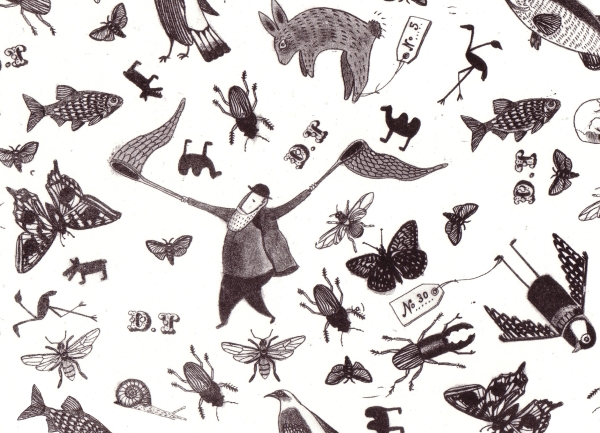Sketching the Universe: Artists' Responses to D'Arcy Thompson
3 September - 6 November 2010, Lamb Gallery, Tower Building, University of Dundee
Mon-Fri 09.30-20.30 Sat 09.30-16.30

Detail of illustration by Lauren Gentry
D'Arcy Thompson was the first Professor of Biology (and later Natural History) at University College, Dundee. His 1917 classic On Growth and Form was written here at the University but has had an international impact. In applying the laws of mathematics to the world of biology, D'Arcy hoped to provide "the first outlines for a sketch of the Universe".
D'Arcy had a keen interest in the arts and since his childhood was closely associated with many notable artists. He could not have predicted, however, the extraordinary influence that his work would have on some of the most celebrated artists and designers of the 20th century. Today artists both locally and internationally continue to draw on his writings and collections for inspiration.
A selection of work by some of these artists is presented in this exhibition, curated by the University of Dundee Museum Services as part of a year-long programme to mark the 150th anniversary of D'Arcy's birth. Accompanying this exhibition in the Tower Foyer Gallery is a selection of work by the abstract painter Wilhelmina Barns-Graham, one of the few artists inspired by D'Arcy's work who had actually met the great man. Read about the exhibition.

Remains by Catherine McIntyre
On Growth and Form
"beyond comparison the finest work of literature in all the annals of science that have been recorded in the English tongue" - P D Medawar
On Growth and Form is the book for which D'Arcy remains best known today. It was a pioneering work, suggesting that the development of living organisms was determined by physical and mathematical laws. D'Arcy used examples throughout the natural world, from nautilus shells and narwhal tusks to soap bubbles and snow flakes.
The book made an immediate impact when it was published in 1917, praised by specialist and general critics alike. It is recognised as the founding classic of mathematical biology, and with the growth of computer-based mathematical modelling techniques and increasing interest in evolutionary-developmental biology (or 'evo-devo'), the scientific influence of D'Arcy's work continues to grow.
It was in the early 1930s that artists first started to find inspiration in On Growth and Form. The sculptor Henry Moore seems to have been the first to discover the book and was soon discussing it with the influential art critic Herbert Read. He introduced it to many of the St Ives circle of artists such as Barbara Hepworth and Naum Gabo. For these pioneers of abstract art in Britain, D'Arcy's work shared their concern with revealing hidden structures of life.
A second edition of On Growth and Form was published in 1942, and was enthusiastically taken up by a group of graduates from the Slade School of Art in London, including Nigel Henderson, Richard Hamilton, Eduardo Paolozzi and the Dundee-born William Turnbull. In 1951, Hamilton staged an influential exhibition called Growth and Form at Herbert Read's new Institute of Contemporary Art (ICA).
Hamilton's exhibition was opened by the renowned architect and designer Le Corbusier, another D'Arcy enthusiast. On Growth and Form had now reached an international audience. It inspired former Bauhaus artists and designers Laszlo Moholy-Nagy and Mies van der Rohe. In the USA, the abstract expressionist painter Jackson Pollock had a copy of the book in his studio.
Since then many other artists around the world have drawn on D'Arcy's work, and the collections from his Zoology Museum continue to inspire artists here in Dundee, including many students from Duncan of Jordanstone College of Art & Design.
The following artists are represented in the exhibition: Amy Barber, David Bowen, Chloe Brown, George Dutch Davidson, Susan Derges, Raydale Dower, David Shanks Ewart, Lauren Gentry, Richard Hamilton, Paul Harrison, Nigel Henderson, Jan Hendry, Jamie Johnson, Ben Laposky, Catherine McIntyre, Will Maclean, Lisa Mason, Henry Moore, Sally Osborn, Jeanine Osborne, Eduardo Paolozzi, Victor Pasmore, Gavin Renwick, Vicki Ross, Lara Scouller, George Clark Stanton and Elizabeth Thacker.
Click the links below to find out more
- Wilhelmina Barns-Graham exhibition
- Sketching the Universe conference
- Special Events Programme
- New Publication
- D'Arcy Thompson Zoology Museum
- D'Arcy Thompson 150 Website